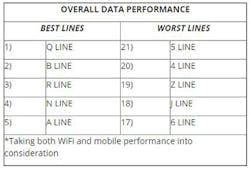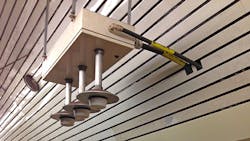Wi-Fi Network Making Progress in NYC Subway Stations
In 2010, the Metropolitan Transit Authority (MTA) announced that it would begin to roll out Wi-Fi and cellular voice and data service in New York City subway stations. The announcement launched an infrastructure project that would involve feeding miles of optical cable under the city streets and building a wireless network that supported several major wireless carriers. An independent benchmarking firm, Global Wireless Solutions (GWS), recently evaluated the current status of the project. The firm tested which stations commuters could expect to successfully connect to Wi-Fi and cellular networks and what kind of quality they could expect.
The wireless infrastructure is being installed by Transit Wireless, a New York-based company formed explicitly to design Wi-Fi and cellular coverage in the New York City subway. The firm—a subsidiary of Broadcast Australia—won the contract from the MTA in 2007 to build out the network and maintain the infrastructure for 25 years. Once the network is installed, commuters will be able to connect to AT&T, Sprint, T-Mobile USA, and Verizon Wireless networks, or sign on to Wi-Fi via the Transit Wireless network.
The tests showed that the project, which is scheduled for completion in 2018, is still a work in progress. GWS tested 67 underground stations with access to the public transit network and revealed that stations on the Q line provide the highest quality of experience on mobile phones. On the other hand, the 4 line was the worst-performing for Wi-Fi connections, with only 2 of 22 stations having access to Wi-Fi networks. In addition, the tests confirmed that six stations had no detectable Wi-Fi signals.
The underground network is based on the concept of a distributed antenna system (DAS). RF nodes are installed in each station and send out signals to other antennas in the station, providing cellular voice and data coverage through the carrier networks, or Wi-Fi service through the Transit Wireless network. According to Nathan Cornish, director of RF engineering at Transit Wireless, the RF nodes are connected back to the Transit Wireless base station hotel via optical fiber. In the base-station hotel, the major cellular carriers each operate a separate base station and equipment supporting 3G, 4G, and LTE networks.
To test the availability and quality of these networks, GWS used a portable benchmarking system, the QualiPoc Freerider from SwissQual, a subsidiary of Rohde & Schwarz. Using five Samsung Galaxy S5 smartphones as measurement channels, the instrument examined voice, video, and message data from carrier networks. The metrics included upload and download speeds and task attempts and completions. For Wi-Fi, the average upload speed was 7.8 Mbits/s and the average download speed was 8.7 Mbits/s. Using mobile data, on the other hand, the average upload speed was 5.6 Mbits/s and the average download speed was 12.8 Mbits/s.
One of the main challenges with the project, Cornish explained in a recent interview with Fast Company , is adapting wireless infrastructure to a subway system that was built over a hundred years ago. In designing the antenna system, Transit Wireless had to account for environmental factors, like extreme temperatures, potential water damage, and metal dust from train brakes. The other problem with installing the equipment, he says, is working around trains that rarely stop running.
With the New York City subway serving almost 1.7 billion commuters per year, city officials have been committed to expanding wireless access into stations. "The city of New York has not been shy with its intentions to dramatically increase Wi-Fi and mobile connectivity for city dwellers and visitors over the past few years," says Dr. Paul Carter, chief executive of GWS.
"Adding and improving wireless service at more subway stations provides a much-anticipated boost to riders’ experience in one of the world’s busiest and oldest subway systems,” said New York Gov. Andrew Cuomo last year, when the Transit Wireless project expanded into the borough of Queens. He added that cellular and Wi-Fi services could also improve responses to emergencies in the subway and provide more accurate train information to commuters.
According to the Transit Wireless website, about 120 of 279 stations in the subway system have been outfitted with cellular and Wi-Fi services. Transit Wireless anticipates a complete rollout of Wi-Fi services to all stations by 2017, ahead of the 2018 schedule.


